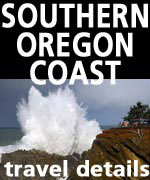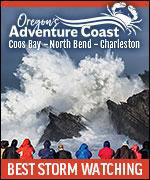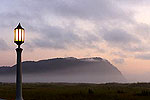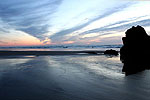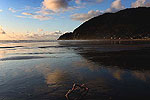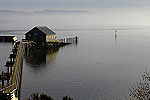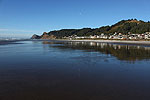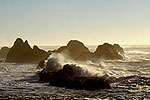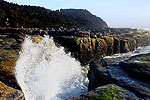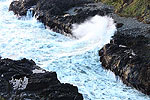Gnarly Oregon Coast Find That Can Sting Badly: Lions Mane Jellyfish
Published 09/22/20 at 5:41 PM PDT
By Oregon Coast Beach Connection staff
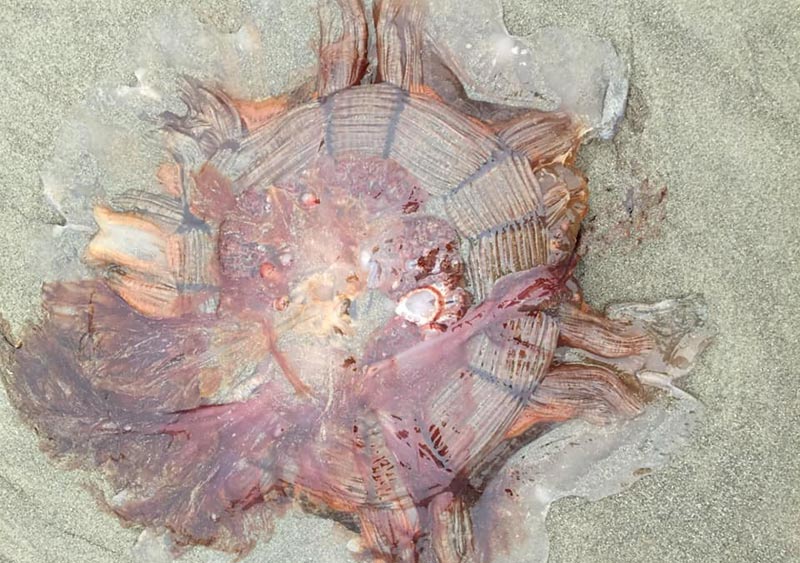
Includes exclusive listings; some specials in winter
In Cannon Beach:
Includes rentals not listed anywhere else
In Manzanita, Wheeler, Rockaway Beach:
Some specials for winter
In Pacific City, Oceanside:
Some specials for winter
In Lincoln City:
Some specials for winter
In Depoe Bay, Gleneden Beach:
Some specials for winter
In Newport:
Look for some specials
In Waldport
Some specials for winter
In Yachats, Florence
Some specials for winter
(Rockaway Beach, Oregon) – A simple walk on the beach in recent weeks took Susan Hansen to a different place. Strolling along the sands of Rockaway Beach, a giant, reddish blob caught her eye near the tideline. Curious, she snaps a few photos and sends a query to Oregon Coast Beach Connection. “Jellyfish family?” she asks. (Photo above courtesy Susan Hansen)
In turn, the question is passed to Seaside Aquarium’s Tiffany Boothe. She responds: “It’s a Lion's Mane (Cyanea capillata). This bad boy can deliver a nasty sting and get up to 6 feet across with a tentacle trail that can be 30 to over 100 feet long.”
Indeed, the Lions Mane often reaches to 120 feet long with its gargantuan tentacles, but the bell is on average two to six feet in diameter.
On the darker side, these can sting people for a few days after they’ve washed up. The good news they don’t wash up very often.
It’s not that they’re especially rare off the Oregon or Washington coast, according Oregon Coast Aquarium’s Director of Animal Husbandry Jim Burke. They simply don’t wash up with frequency because their population is not that dense.
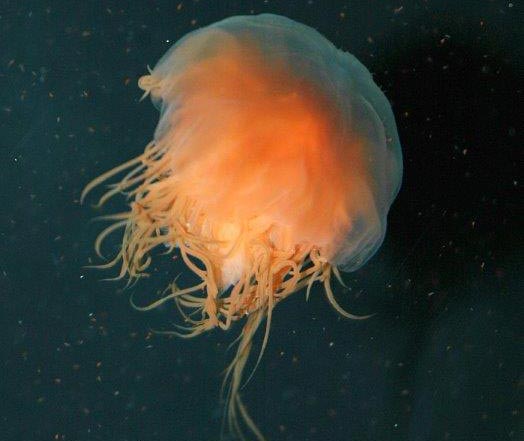
Lions Mane at Oregon Coast Aquarium, courtesy photo
“We see them every year,” Burke said. “They are denser up north in Alaska, but we do get them. They’re just not as dense as other jellies or sea nettles.”
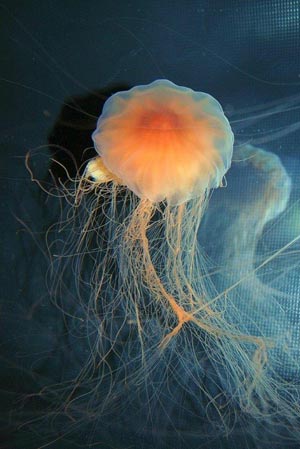 Lions Mane jellies don’t live that far offshore, and they are usually fairly near the surface, within 66 feet of the water line.
Lions Mane jellies don’t live that far offshore, and they are usually fairly near the surface, within 66 feet of the water line.
“You see them most any year at this time,” he said. “But yeah, they don’t hit the beach that much because there just aren’t that many of them. They’re pretty big and strong, and we haven’t had a storm yet.”
Those tentacles reach as much as 120 feet in some individuals, which rivals the largest of sea creatures. This one that Hansen photographed was somewhat reddish and brown, with what looks like masses of electrical wiring beneath its gelatinous bell. Over their short lives – about a year or two – the Lions Mane periodically changes color.
As for the sting, well you simply don’t want to touch one, just in case. It tends to affect people more when they have sensitivities to jellyfish stings, and that’s something you won’t know about until one stings you.
“They have really long tentacles, and their nematocysts are stronger than sea nettles or moon jellies,” he said.
That means the parts of the tentacles that contain the toxin – what does the actual stinging is called a nematocyst.
“If you have a sensitivity, they’ll definitely pack a sting for many days after they’ve been on the beach. It’s not like a Box jelly or Man ‘O War where you’re potentially losing some tissue, though. But they have a fairly strong sting that you’ll get a rash from.”
It's important to note other, smaller jellies like moon jellies or sea nettles will not sting, although it's best to leave them alone just in case you're sensitive.
Of their reproduction, Burke said they spawn in water via sperm and eggs, and then the fertilized object settles onto a harder surface or even kelp. From there, polyps form and each produces multiple medusa – meaning small jellies.
“They get pretty big,” Burke said. “Generally they live in northern climates and become the victim of waves, storms.”
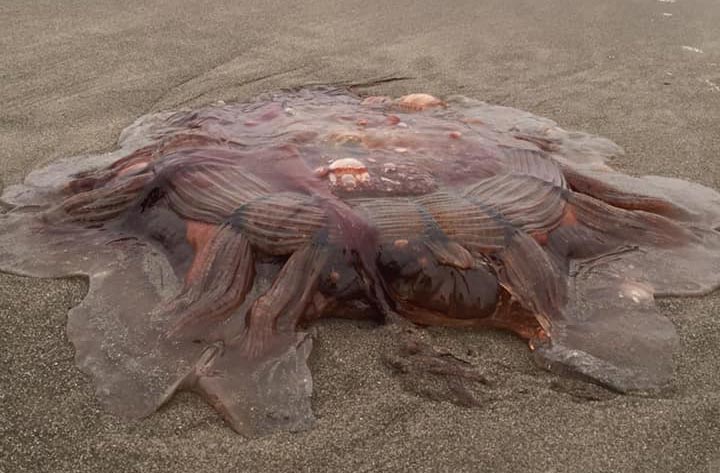
Courtesy Susan Hansen
Like any jellyfish, they have little to no ability to swim on their own and are at the mercy of currents. Also like their brethren, they have no hearts or brains. The surprise, however, is that they may have bioluminescent qualities on their own, meaning they can give off a glow. That’s the subject of some debate, however. Burke said he’s never seen one glow. A stranger twist: he believes that if they have that capability it could come from the fact they eat bioluminescent creatures as part of their steady diet, which could in turn give them that ability at times.
It’s a truly weird case of “you are what you eat.”
Another freaky fact: they sometimes get to feast on creatures looking to hide inside them. Some smaller fishes like to look for places to duck away from predators, and sometimes hapless fish will choose the tentacles of the Lions Mane to hide in, thereby becoming the lunch they were ironically trying to avoid.
Oregon Coast Aquarium has had the Lions Mane on display before. The last time was about two years ago. Burke said they’re a bit difficult to host, however.
“We’ve cultured them before, meaning we start with the polyps and grow them up,” he said. “We’ve tried to put the big ones in our tank – our jellyfish tanks are specifically designed. But they’re not big enough, and their tentacles get too stuck to the drain.”
Oregon Coast Aquarium then has to find a new institution for the Lions Mane.
Oregon Coast Hotels in this area - Where to eat - Maps - Virtual Tours
Cannon Beach Lodging
Nehalem Bay Lodgings
Manzanita Hotels, Lodging
Three Capes Lodging
Pacific City Hotels, Lodging
Lincoln City Lodging
Depoe Bay Lodging
Newport Lodging
Waldport Lodging
Yachats Lodging
Oregon Coast Vacation Rentals
Oregon Coast Lodging Specials
More About Oregon Coast hotels, lodging.....
More About Oregon Coast Restaurants, Dining.....
LATEST Related Oregon Coast Articles
Travel Advice: Traffic Cams for I-5, I-205, I-405, Hwy 217, I-84, OR 26
Low Tide Oceanside Events Take You Deeper Into N. Oregon Coast Tidepools
June 13, 26, 27, and 28, these uncover the wonders at the water's edge. Oceanside events, Pacific City events, Tillamook events, Netarts
Military Truck Tours Back at Fort Stevens, Go Back in Time on N. Oregon Coast
Hop aboard a five-ton military truck and rove around the grounds. History. Astoria events, Warrenton
Newport Astrophotography Events Bring the Universe to Central Oregon Coast
July 25 at Frank Wade Park, August 16 at Newport Rec Center, Aug. 23 - 24 road trip. Nwport events
Lincoln City Summer Kite Fest Returns, with Nod to Oregon Coast's Famed Pixie...
June 21 - 22 at the D River State Recreation Site. Lincoln City events
Rare Lunar Event Tonight Won't Happen Again for Almost 20 Years: Oregon, Wash...
Moon at lowest on the horizon it's been in 20 years; plus 'full moon effect'. Sciences, astronomy
Bandon's Circles in the Sand Returns to S. Oregon Coast, Full Summer and Shut...
Into mid-August with parking shuttles a great assist. South coast events, Bandon events
Summer's Surprise Rate Drops in July On Oregon Coast Include Lincoln City Bea...
20 percent some vacation rentals in the heat of July's highest rates. Lincoln City lodging specials, Lincoln City hotel reviews
Back to Oregon Coast
Contact Advertise on BeachConnection.net
All Content, unless otherwise attributed, copyright BeachConnection.net Unauthorized use or publication is not permitted












